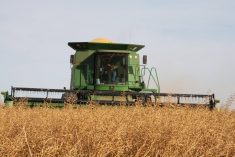Do growers use grain bags when their crops are larger than expected? Or, are farmers now using grain bags instead of bins?
Craig Yeager, owner of GBC Equipment, a company in Humboldt, Sask., that sells grain bags, said grain bags aren’t just for secondary storage. More farmers use them during harvest because they allow busy operators to quickly store grain rather than trucking it to a bin.
“A lot of the guys are using the baggers to get going in the fall,” Yeager said in November.
Read Also

New program aims to support plant-based exports to Asia
Understanding the preferences of consumers in Taiwan and how they differ from Indonesia or Malaysia isn’t easy for a small company in Saskatchewan.
“They can keep the wheels turning.”
If more producers are using grain bags as their first option, some may wonder how long it’s feasible to store grain in a 60 to 75 metre-long bag, which can hold 200 to 300 tonnes of grain.
University of Manitoba researchers have tried to answer that question for the most valuable crop on the Prairies; canola.
U of M scientists conducted studies on canola in grain bags from 2010-14. The Canola Council of Canada provided funding for the research.
In 2016, Chella Vellaichamy, a researcher in Biosystems Engineering at the University of Manitoba, published papers on the grain bag research.
Vellaichamy and his U of M colleagues conducted two studies. In the first they placed dry, normal and damp canola into silo bags. Dry was 8.9 percent moisture, 10.5 was normal and 14.4 percent was damp.
Vellaichamy kept the canola in the bags for 40 weeks and took periodic samples to measure quality indicators like seed germination and free fatty acid value (FAV).
The Canola Council reported that dry canola, which graded No. 1 at the beginning of the study was still No. 1 after 40 weeks in the bag.
The normal moisture canola dropped to No. 2 grade and the damp canola was downgraded to feed quality.
In the second study, the U of M team looked at 12 percent moisture canola, stored in silo bags for 20 weeks, 28 weeks and 40 weeks.
They found there was little change in quality after 16 weeks and the germination of canola seed in most parts of the silo bag were above a safe level for 20 weeks of storage.
But after 40 weeks, the canola in the bag deteriorated to feed grade in the first year of the study. The second time the study was done, the 12 percent moisture canola dropped to No. 2 grade.

















